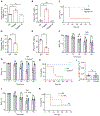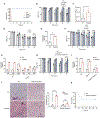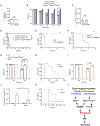Pyroptosis of pulmonary fibroblasts and macrophages through NLRC4 inflammasome leads to acute respiratory failure
- PMID: 40158217
- PMCID: PMC12087274
- DOI: 10.1016/j.celrep.2025.115479
Pyroptosis of pulmonary fibroblasts and macrophages through NLRC4 inflammasome leads to acute respiratory failure
Abstract
The NAIP/NLRC4 inflammasome plays a pivotal role in the defense against bacterial infections, with its in vivo physiological function primarily recognized as driving inflammation in immune cells. Acute lung injury (ALI) is a leading cause of mortality in sepsis. In this study, we identify that the NAIP/NLRC4 inflammasome is highly expressed in both macrophages and pulmonary fibroblasts and that pyroptosis of these cells plays a critical role in lung injury. Mice challenged with gram-negative bacteria or flagellin developed lethal lung injury, characterized by reduced blood oxygen saturation, disrupted lung barrier function, and escalated inflammation. Flagellin-induced lung injury was protected in caspase-1 or GSDMD-deficient mice. These findings enhance our understanding of the NAIP/NLRC4 inflammasome's (patho)physiological function and highlight the significant role of inflammasome activation and pyroptosis in ALI during sepsis.
Keywords: CP: Immunology; inflammasome; lung injury; pyroptosis; sepsis.
Copyright © 2025 The Authors. Published by Elsevier Inc. All rights reserved.
Conflict of interest statement
Declaration of interests The authors declare no competing interests.
Figures






References
-
- Miao EA, Alpuche-Aranda CM, Dors M, Clark AE, Bader MW, Miller SI, and Aderem A (2006). Cytoplasmic flagellin activates caspase-1 and secretion of interleukin 1beta via Ipaf. Nat. Immunol 7, 569–575. - PubMed
-
- Zhao Y, Yang J, Shi J, Gong YN, Lu Q, Xu H, Liu L, and Shao F (2011). The NLRC4 inflammasome receptors for bacterial flagellin and type III secretion apparatus. Nature 477, 596–600. - PubMed
MeSH terms
Substances
Grants and funding
LinkOut - more resources
Full Text Sources
Molecular Biology Databases
Miscellaneous

